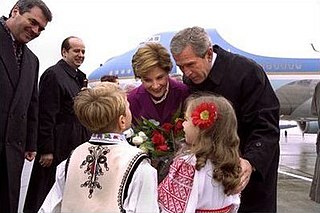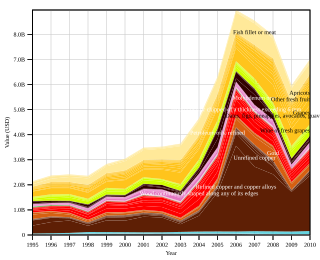
The North American Free Trade Agreement was an agreement signed by Canada, Mexico, and the United States that created a trilateral trade bloc in North America. The agreement came into force on January 1, 1994, and superseded the 1988 Canada–United States Free Trade Agreement between the United States and Canada. The NAFTA trade bloc formed one of the largest trade blocs in the world by gross domestic product.

The Dominican Republic–Central America–United States Free Trade Agreement is a free trade agreement. Originally, the agreement encompassed the United States and the Central American countries of Costa Rica, El Salvador, Guatemala, Honduras, and Nicaragua, and was called CAFTA. In 2004, the Dominican Republic joined the negotiations, and the agreement was renamed CAFTA-DR.
The Australia – United States Free Trade Agreement (AUSFTA) is a preferential trade agreement between Australia and the United States modelled on the North American Free Trade Agreement (NAFTA). The AUSFTA was signed on 18 May 2004 and came into effect on 1 January 2005.

The main event by far shaping the foreign policy of the United States during the presidency of George W. Bush (2001–2009) was the 9/11 terrorist attacks against the United States on September 11, 2001, and the subsequent war on terror. There was massive domestic and international support for destroying the attackers. With UN approval, US and NATO forces quickly invaded the attackers' base in Afghanistan and drove them out and the Taliban government that harbored them. It was the start of a 20-year quagmire that finally ended in failure with the withdrawal of United States troops from Afghanistan.
The US-Morocco Free Trade Agreement is a bilateral trade agreement between the United States and Morocco. The agreement was signed on June 15, 2004, followed by U.S. President George W. Bush's signing of the USMFTA Implementation Act on August 17, 2004. The United States House of Representatives ratified the pact on July 22, 2004 by a 323–99 vote. The United States Senate passed the bill by unanimous consent on July 21, 2004. The Morocco FTA came into effect on January 1, 2006.

The Trade Act of 1974 was passed to help industry in the United States become more competitive or phase workers into other industries or occupations.
The United States–Peru Trade Promotion Agreement is a bilateral free trade agreement, whose objectives are eliminating obstacles to trade, consolidating access to goods and services and fostering private investment in and between the United States and Peru. Besides commercial issues, it incorporates economic, institutional, intellectual property, labor and environmental policies, among others. The agreement was signed on April 12, 2006; ratified by the Peruvian Congress on June 28, 2006; by the U.S. House of Representatives on November 2, 2007, and by the U.S. Senate on December 4, 2007. The Agreement was implemented on February 1, 2009.

The U.S.-Oman Free Trade Agreement is a trade pact between Oman and the United States. On November 15, 2004, the George W. Bush administration notified the U.S. Congress of its intent to sign a trade agreement with the Middle Eastern Sultanate of Oman. On January 19, 2006 the two countries signed the U.S.-Oman Free Trade Agreement (OFTA), which is part of the Bush administration's strategy to create a US - Middle East Free Trade Area (MEFTA) by 2013.
The United States–Jordan Free Trade Agreement is the first free trade agreement (FTA) between the United States and an Arab country. It is Jordan's second free trade agreement, after the 1997 Greater Arab Free Trade Agreement. The agreement, which grants duty-free status to nearly all Jordanian exports to the United States, was signed on 24 October 2000 and went into force on 17 December 2001. Rules of origin require that goods be composed of a minimum of 35 percent Jordanian content to be eligible for duty-free entry.

The United States–Bahrain Free Trade Agreement (USBFTA) is a free trade agreement (FTA) between the United States and Bahrain, signed on September 14, 2004. It was ratified by the United States House of Representatives on December 7, 2005, by 327–95, with 10 not voting.
The United States–Israel States Free Trade Agreement (FTA) is a trade pact between the State of Israel and the United States of America established in 1985 to lower trade barriers in some goods. The agreement reduces rates of duty, and in some case eliminates all duties, on merchandise exported from Israel to the United States. The agreement also covers merchandise exported from the Gaza Strip and the West Bank.
The United States-Colombia Trade Promotion Agreement (CTPA) is a bilateral free trade agreement between the United States and Colombia. Sometimes called the Colombia Free Trade Agreement, it was signed on November 22, 2006, by Deputy U.S. Trade Representative John Veroneau and Colombian Minister of Trade, Industry, and Tourism Jorge Humberto Botero. CTPA is a comprehensive agreement that will eliminate tariffs and other barriers to trade in goods and services between the United States and Colombia, including government procurement, investment, telecommunications, electronics commerce, intellectual property rights, and labor and environmental protection The United States Congress. Colombia's Congress approved the agreement and a protocol of amendment in 2007. Colombia's Constitutional Court completed its review in July 2008, and concluded that the Agreement conforms to Colombia's Constitution. President Obama tasked the Office of the U.S. Trade Representative with seeking a path to address outstanding issues surrounding the Colombia FTA. The United States Congress then took on the agreement and passed it on October 12, 2011. The agreement went into effect on May 15, 2012.
The fast track authority for brokering trade agreements is the authority of the President of the United States to negotiate international agreements in an expedited manner and with limited congressional oversight. Renamed the trade promotion authority (TPA) in 2002, the TPA is an impermanent power granted by Congress to the President. It remained in effect from 1975 to 1994, pursuant to the Trade Act of 1974 and from 2002 to 2007 pursuant to the Trade Act of 2002. Although it technically expired in July 2007, it remained in effect for agreements that were already under negotiation until their passage in 2011. In June 2015, a third renewal passed Congress and was signed into law by President Barack Obama.

The United States–Korea Free Trade Agreement, also known as KORUS FTA, is a trade agreement between the United States and South Korea. Negotiations were announced on February 2, 2006, and concluded on April 1, 2007. The treaty was first signed on June 30, 2007, with a renegotiated version signed in early December 2010.

Bahrain and the United States have been allies since Bahrain's independence in 1971 and have maintained close relations with shared mutual interests across economic and geopolitical lines.

The United States is party to many free trade agreements (FTAs) worldwide.
Qualifying industrial zones (QIZs) are industrial parks that house manufacturing operations in Jordan and Egypt. The QIZ program was introduced in 1996 by the U.S. Congress to stimulate regional economic cooperation. Goods produced in QIZ-designated areas in Egypt, Jordan and the Palestinian territories can directly access U.S. markets without tariff or quota restrictions, subject to certain conditions. To qualify, goods produced in these zones must contain a small portion of Israeli input. In addition, a minimum 35% value to the goods must be added to the finished product. The idea was first proposed by Jordanian businessman Omar Salah in 1994.

The United States-Chile Free Trade Agreement is a free trade agreement (FTA) between the United States and Chile signed on June 6, 2003. The pact came into force on January 1, 2004. On that date, tariffs on 90% of U.S. exports to Chile and 95% of Chilean exports to the United States were eliminated. The agreement also established that Chile and the U.S. will establish duty-free trade in all products within a maximum of 12 years (2016). In 2009, bilateral trade between the United States and Chile reached US$15.4 billion, a 141% increase over bilateral trade levels before the U.S.-Chile FTA took effect. In particular, U.S. exports to Chile in 2009 showed a 248% increase over pre-FTA levels.
The H-1B1 visa is a variant of the H-1B visa in the United States for nationals of Singapore and Chile. The version for Singapore is called the H-1B1-Singapore and the version for Chile is called the H-1B1-Chile. These categories were introduced with the Singapore–United States Free Trade Agreement and Chile–United States Free Trade Agreement respectively, both of which were ratified in 2003 by the 108th United States Congress and became active on January 1, 2004. The visas are also called FTA visas because they were provided for through Free Trade Agreements (FTAs).

The Agreement between the United States of America, Mexico, and Canada (USMCA) is a free trade agreement between the United States, Mexico, and Canada. It replaced the North American Free Trade Agreement (NAFTA) implemented in 1994, and is sometimes characterized as "NAFTA 2.0", or "New NAFTA", since it largely maintains or updates the provisions of its predecessor. USMCA is one of the world's largest free trade zones, with a population of more than 510 million people and an economy of $30.997 trillion in nominal GDP — nearly 30 percent of the global economy.












